Identification Codes
Vehicle Identification Number
(VIN) Locator

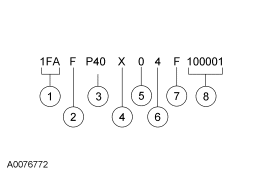
The vehicle identification
number (VIN) is a seventeen-digit alphanumeric code. The VIN is stamped on a metal tab riveted to the instrument panel, top
upper left of the dash. The VIN number is also found on the vehicle certification (VC) label.

Item | Description |
1 | World manufacturer
identifier (WMI) |
2 | Restraint type code |
3
| Line, series, body type (passenger car) |
4 | Engine code |
5 | Computer generated
VIN check digit |
6 | Model year code |
7 | Assembly plant code |
8 | Production sequence number |
Vehicle Identification Number
World
Manufacturer Identifier (WMI)
World Manufacturer Identifier
(WMI)
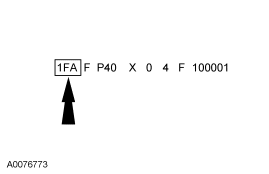
The first three vehicle identification number (VIN)
positions are the world manufacturer identifier (WMI).
1FA — Ford, USA, passenger
car
Restraint Type Code
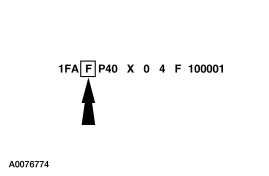
The fourth VIN position is the vehicle restraint system type code.
F — Active safety belts — all positions, driver and front passenger air bags
Line, Series and Body Type Code

Positions 5 through 7 indicate vehicle line, series and body type.
P40 — Two-door coupe
P42 — Two-door coupe, GT (Mach
One available in GT Coupe only)
P44 — Two-door convertible
P45
— Two-door convertible, GT
P48 — Two-door coupe, Cobra
P49
— Two-door convertible, Cobra
Engine Code

The eighth VIN position is the engine displacement and number of cylinders code.
4 — 3.8L, OHV, EFI, six cylinder
R — 4.6L, DOHC,
EFI, eight cylinder (Mach One)
X — 4.6L, SOHC, EFI, eight cylinder
Y— 4.6L, DOHC, S/C, EFI, eight cylinder (Cobra)
Computer
Generated Check Digit
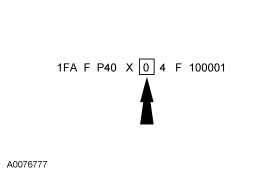
The ninth VIN position is a government assigned, computer-generated check digit
code (0-9).
Model Year Code
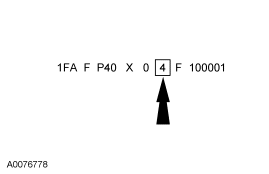
The tenth VIN position is the model year code.
3 2003
4 — 2004
Assembly
Plant Code
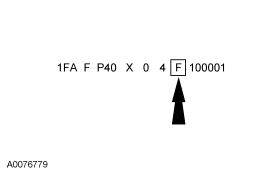
The eleventh VIN position is the assembly plant code.
F — Dearborn, Michigan (USA)
Production Sequence Number
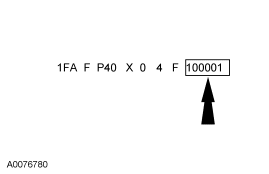
The last six VIN positions are the production sequence number. This number is also
used as the vehicle serial and warranty number.
100001-599999
Vehicle Certification (VC) Label
Vehicle Certification (VC) Label Locator

Vehicle Certification (VC) Label Locator

The upper portion of the vehicle certification (VC)
label contains the manufacturer name, the month and year of manufacture, the certification statement and the VIN. It also
includes gross vehicle weight ratings (GVWR). The VC label is located on the left-hand door jamb.

Item | Description |
1 | Exterior paint color code |
2 | Region code |
3 | Special order
code
(DSO — domestic special order
FSO — foreign special order
PTO — paint, tire option
special order) |
4 | Brake type code |
5 | Interior trim code |
6 | Tape/paint stripe code |
7 | Radio type code
|
8 | Axle ratio code |
9 | Transmission code |
10 | Spring code |
11
| Powertrain calibration code |
Vehicle Certification (VC) Label Reference
Paint Codes

The first set of paint code letters/numbers listed
indicate the vehicle primary body color. The second set of paint code letters/numbers listed (if applicable) indicate a two-tone
or accent body color. All colors are base coat/clear coat.
CX — Dark
Shadow Gray Metallic
CY — Competition Orange (water based)
D3
— Colorado Red
D6 — Screaming Yellow (water based)
FX
— Merlot — 40th Anniversary Edition
G2 — Redfire (water based)
G6 — Purple Haze (water based) — Cobra
L5 — Azure Blue (water based)
— Mach One
SN — Sonic Blue (water based)
UA —
Ebony (water based)
YN — Silver Metallic (water based)
Z1
— Oxford White (water based)
Brake Codes
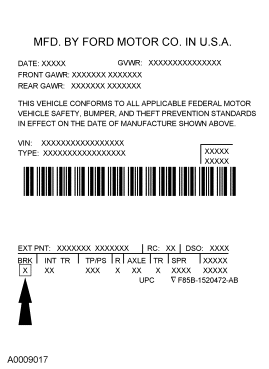
The brake type codes are:
2 —
Four-wheel disc with anti-lock brake system (ABS)
3 — Traction control
5 — Four-wheel disc with anti-lock brake system (ABS) and traction control
Interior Trim Codes

The interior trim codes are listed below. The first letter/number is for the
interior fabric. The second letter is for the interior color.
9 —
Rhodes cloth
A — Link Weave cloth — Mach One
B —
Imola leather
G — Imola leather (sport seat)
M — Nudo
leather — Cobra
U — Shadow/Twill cloth
The interior
trim colors are:
2 — Medium Graphite
D
— Midnight Black/Mystichrome — Cobra
H — Medium Parchment
W — Midnight Black
Z — Oxford White
Tape/Paint Stripe Codes
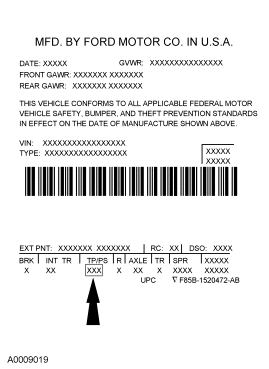
P — White/Gray (tape applique emblem)
X — Black (hood and body
tape stripe)
4 — Arizona Beige (anniversary car accent stripe)
Radio Codes
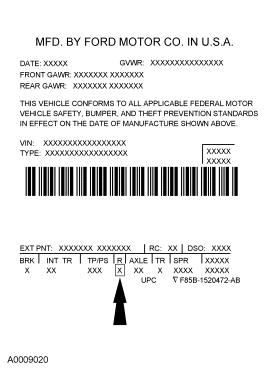
The radio type codes are:
2 — Premium electronic AM/FM stereo with compact disc (CD) player and clock
9 —
CDX6+, AM/FM stereo with 6-disc compact disc (CD) changer and MACH 460 subwoofer sound system
Z
— AM/FM stereo, dual media (MP3) with compact disc (CD) player
Axle
Ratio Codes
The axle ratio is: 
Blank — 2.73 ratio
Blank — 3.27 ratio
Blank
— 3.55 ratio
Transmission Codes
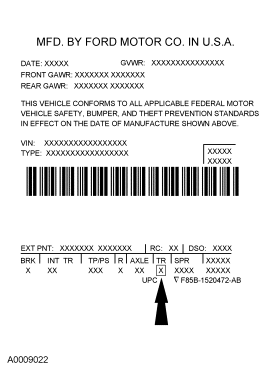
The transmission code is:
9 —
Four-speed automatic (4R75W) — GT
B — Six-speed manual (T56) — Cobra
G — Five-speed manual (TR3150) — Base
K — Five-speed manual (TR3650)
— GT
U — Four-speed automatic (4R70W) — Base
Spring Codes

The spring code portion of the vehicle certification (VC) label identifies
both the front and rear springs. The first letter/number indicates the front spring code. The second letter/number indicates
the rear spring code.
Front springs — base part number — 5310
(RH/LH)
Rear springs — base part number — 5560 (RH/LH)
Powertrain Calibration Information
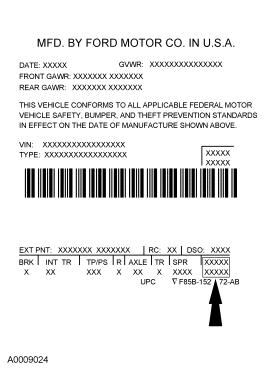
NOTE: Powertrain calibration information is limited to a maximum of five characters per
line on the Vehicle Certification Label. Because of this, calibration identification consisting of more than five characters
will wrap to the second line on the VC label.
Powertrain calibration information
is printed in the lower right corner of the Vehicle Certification Label. Only the base calibration information is printed.
Revision levels will not appear, however, this information can be found in the On Line Automotive Service Information System
(OASIS). For the current model year, Ford Motor Company is using three different protocols which describe powertrain base
calibration. These protocols are designed to provide worldwide standardization for vehicle calibration. If the electronic
calibration strategy has been used since 1998 and carried into the current model year, protocol 1 will be used. Refer to Protocol
1 below. If the electronic calibration strategy has been used since 1999 and is carried into the current model year, protocol
2 will be used. Refer to Protocol 2 below. For new electronic calibration strategies introduced since the 2000 model year,
use protocol 3. Refer to Protocol 3 below.
Protocol 1

Item | Description |
1 | Model year (model
year in which calibration strategy was first introduced) |
2
| Engine code |
3 | Engine revision level |
Protocol 2

Item | Description
|
1 | Model year (model year in which calibration strategy was first introduced) |
2 | Engine code |
3 | Transmission code
|
4 | Emission standard (designates the specific country emission standard) |
5 | Design level (design level assigned
to the engine) |
Protocol 3
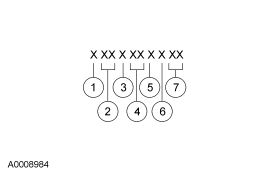
Item | Description |
1 | Model year (model
year in which calibration strategy was first introduced) |
2
| Vehicle code |
3 | Transmission code |
4 | Unique calibration (designates
different hardware to similar vehicles). Example: tires, drive ratios, etc. |
5 | Fleet code (describes fleet to which the vehicle
belongs). Example: 6 - evaporative emissions |
6 | Certification region (lead region where multiple regions are included in one calibration).
Example: A - U.S. federal |
7 | Revision level (will advance as revisions occur). Not printed on label |
Protocol 3
The following offers
a more detailed explanation of the coding strategy used for protocol 3.
Model
Year
Y — 2000
1 — 2001
2
— 2002
3 — 2003
4 — 2004
Y — 2000
1 — 2001
2 — 2002
3 — 2003
4 — 2004
Vehicle Line
ZE — Mustang
ZE — Mustang
Transmission
1 — Automatic transmission
2 — Manual transmission
1 — Automatic transmission
2 — Manual transmission
The following offers a more detailed explanation of the coding strategy used
for protocol 3.
Model Year
Y — 2000
1 — 2001
2 — 2002
3 — 2003
4 — 2004
Y — 2000
1 — 2001
2 — 2002
3 — 2003
4 — 2004
Vehicle Line
ZE — Mustang
ZE — Mustang
Transmission
1 — Automatic transmission
2 — Manual transmission
1 — Automatic transmission
2 — Manual transmission
Unique Calibration
The Emissions/CAFE/CO2 Compliance Department is responsible for assigning these calibration
numbers. Unique calibration identifications are assigned to cover similar vehicles to differentiate tires, drive configurations,
final drive ratios and other calibration-significant factors.
These two characters
are chosen by the analyst to provide easily identifiable information unique to each calibration. For example, using the number
2 to denote a two-valve engine versus using the number 4 to denote a four-valve engine.
Fleet Code
1 — HDGE/Dyno
2
— Fast AMA, U.S.
3 — ADP, U.S.
4 — Not assigned
5 — Not assigned
6 — Evaporative emissions
7 — MACAA
8 — On-board diagnostics (OBD)
9
— Not assigned
Certification Region
5
— U.S. fifty states
A — U.S. federal, including altitude, may include Canada and/or
Mexico
B — U.S. California standard, includes U.S. green states
C
— Canada
D — China
E — European Community (Austria,
Belgium, Denmark, Finland, France, Germany, Greece, Ireland, Italy, Luxembourg, Netherlands, Portugal, Spain, Sweden and United
Kingdom)
F — Extended European Community (E plus Croatia, Czech Republic, Estonia, Hungary,
Norway, Poland, Romania, Russian Federation, Slovakia, Slovenia, Switzerland and Yugoslavia)
G
— Gulf Cooperative Council (Bahrain, Kuwait, Oman, Qatar, Saudi Arabia and UAE)
H —
Hong Kong
J — Japan
K — Korea
L
— Malaysia
M — Mexico
N — New Zealand
P — Australia
Q — South America (Brazil)
S
— Singapore
T — Taiwan
U — South America (unleaded
fuel regions)
V — Vietnam
X — Rest of world (ROW)
Y — Military
Z — Israel
5 —
U.S. fifty states
A — U.S. federal, including altitude, may include Canada and/or Mexico
B — U.S. California standard, includes U.S. green states
C
— Canada
D — China
E — European Community (Austria,
Belgium, Denmark, Finland, France, Germany, Greece, Ireland, Italy, Luxembourg, Netherlands, Portugal, Spain, Sweden and United
Kingdom)
F — Extended European Community (E plus Croatia, Czech Republic, Estonia, Hungary,
Norway, Poland, Romania, Russian Federation, Slovakia, Slovenia, Switzerland and Yugoslavia)
G
— Gulf Cooperative Council (Bahrain, Kuwait, Oman, Qatar, Saudi Arabia and UAE)
H —
Hong Kong
J — Japan
K — Korea
L
— Malaysia
M — Mexico
N — New Zealand
P — Australia
Q — South America (Brazil)
S
— Singapore
T — Taiwan
U — South America (unleaded
fuel regions)
V — Vietnam
X — Rest of world (ROW)
Y — Military
Z — Israel
Revision
Level (not printed on label)
91-99 — Hardware certification levels
01-04 — Preliminary levels
00 — Job 1 production (initial certification)
05-09 — Pre-job 1 revisions to calibrations
10-89 —
Post-job 1 revisions to calibrations
0B — Durability test level
BD
— On-board diagnostics (OBD) intermediate level (pre-05)
91-99 — Hardware
certification levels
01-04 — Preliminary levels
00 —
Job 1 production (initial certification)
05-09 — Pre-job 1 revisions to calibrations
10-89 — Post-job 1 revisions to calibrations
0B — Durability test level
BD — On-board diagnostics (OBD) intermediate level (pre-05)

